Flexural Strength Prediction Models for Soil–Cement from Unconfined Compressive Strength at Seven Days
Abstract
:1. Introduction
2. Materials and Mix Design
2.1. Materials
2.2. Mix Design
3. Experimental Procedure
- Model 1. UCS is the independent variable and the FS is the dependent variable. Model 1 has two versions: an “a” version, without an intercept, and a “b” version with an intercept.
- Model 2. It includes a new independent variable that represents the percentage of the difference between the compaction density of the sample and the maximum dry density value.
- Model 3. It includes a dummy variable as an independent variable, which has a value of 1 if the obtained density is greater than or equal to the maximum dry density of the Modified Proctor and has a value of 0 if the density is less than the maximum dry density.
- Model 4. It includes two dummy variables as independent variables. The first one has a value of 0 if the obtained density is less than or equal to the maximum dry density minus 1% and 1 if the density is over this value. The second dummy variable has a value of 0 if the density is less than or equal to the maximum density plus 1% and 1 if the density is over that value.
- Model 5. It includes two dummy variables as independent variables. The first one has a value of 0 if the obtained density is less than or equal to the maximum dry density minus 1% and 1 if the density is greater than this value. The second dummy variable has a value of 0 if the density is less than or equal to the maximum density and 1 if the density is greater than that value.
- Model 6. It only uses the FS and UCS variables
- Model 7. It includes a new independent variable, which is the difference between the obtained density and the maximum density from the Modified Proctor test, in percentage.
- Model 8. It includes a dummy independent variable, with a value of 1 when the compaction density is greater than or equal to 100% of the Proctor Modified density and 0 when it is less than the Proctor Modified density.
- Linearity of the relationship between the dependent variable and the independent variables. This can be checked by the analysis of variance (ANOVA) analysis.
- Homoscedasticity. This implies that the variance of error term is constant across all values of the independent variables. This is verified by means of a plot of the standardized residuals obtained against the predicted standardized residuals and observing that there is no pattern on it.
- Normality. This means that the error is normally distributed, which can be verified by the Kolmogorov–Smirnov test.
- Each observation is drawn independently from the population, implying that errors are independent from each other. This is checked with the Durbin–Watson test.
- Verifying the signs of the variables.
- Testing the significance of the variables by means of the t-Student test.
- Analyzing the dummy variables, guaranteeing the non-linearity if various ones are introduced at the same time.
- Other criteria, such as the variables employed by each model and the regression coefficient R2.
- A prismatic sample with dimension 15 cm × 15 cm × 60 cm, following the same procedure explained for the previous prismatic samples. The only difference was that a flexible plastic film was placed perpendicular to the length of the mold to manufacture two separated prismatic samples to be tested at 7 and 90 days, respectively.
- Three cylindrical samples with dimension ∅15 × 18 compacted in three layers were tested at 7, 28 and 90 days, respectively.
4. Results and Discussion
4.1. Flexural Strength Test
4.2. Unconfined Compressive Strength Test
4.3. Flexural–Compressive Strength Relationship Models
4.4. Comparison with Other Proposed Models
4.5. Relationship Between UCS at Short and Long Term
5. Summary and Conclusions
- A linear multiple regression models, in which the dependent variable, FS at long term, is estimated from the UCS at long term and a dummy variable that depends on the compaction density (Model 3b).
- A model based on the Cobb–Douglas production function, where FS is the dependent variable and UCS at long term is the independent variable (Model 6b)
- A simple linear regression model where the FS is the dependent variable and UCS at long term is the independent variable (Model 1b)
Author Contributions
Funding
Conflicts of Interest
References
- Nunes, M.C.M.; Bridges, M.G.; Dawson, A.R. Assessment of secondary materials for pavement construction: Technical and environmental aspects. Waste Manag. 1996, 16, 87–96. [Google Scholar] [CrossRef]
- López-Uceda, A.; Ayuso, J.; López, M.; Jimenez, J.; Agrela, F.; Sierra, M. Properties of non-structural concrete made with mixed recycled aggregates and low cement content. Materials 2016, 9, 74. [Google Scholar] [CrossRef] [PubMed]
- López-Uceda, A.; Ayuso, J.; Jiménez, J.; Agrela, F.; Barbudo, A.; De Brito, J. Upscaling the use of mixed recycled aggregates in non-structural low cement concrete. Materials 2016, 9, 91. [Google Scholar] [CrossRef] [PubMed]
- Pérez-Acebo, H.; Linares-Unamunzaga, A.; Abejón, R.; Rojí, E. Research trends in pavement management during the first years of the 21st century: A bibliometric analysis during the 2000–2013 period. Appl. Sci. 2018, 8, 1041. [Google Scholar] [CrossRef]
- Salas, M.Á.; Pérez-Acebo, H.; Calderón, V.; Gonzalo-Orden, H. Bitumen modified with recycled polyurethane foam for employment in hot mix asphalt. Ingeniería e Investigación 2018, 38, 60–66. [Google Scholar] [CrossRef]
- Díaz, J.; Linares, A.; González, D.; Gonzalo-Orden, H. In situ pavement recycling with cement design. In Proceedings of the 4th European Pavement and Asset Management Conference (EPAM), Malmö, Sweden, 5–7 September 2012. [Google Scholar]
- Amato, G.; Campione, G.; Cavaleri, L.; Minafò, G.; Miraglia, N. The use of pumice lightweight concrete for masonry applications. Mater. Struct. 2012, 45, 679–693. [Google Scholar] [CrossRef]
- Pérez-Acebo, H.; Bejan, S.; Gonzalo-Orden, H. Transition probability matrices for flexible pavement deterioration models with half-year cycle time. Int. J. Civ. Eng. 2017, 16, 1045–1056. [Google Scholar] [CrossRef]
- Bejan, S.; Pérez-Acebo, H. Modeling the dynamic interaction between a vibratory-compactor and ground. Rom. J. Acoust. Vib. 2016, 12, 94–97. [Google Scholar]
- Islam, S.; Haque, A.; Bui, H. 1-D compression behaviour of acid sulphate soils treated with alkali-activated slag. Materials 2016, 9, 289. [Google Scholar] [CrossRef]
- Zhang, Y.; Guo, Q.; Li, L.; Jiang, P.; Jiao, Y.; Cheng, Y. Reuse of boron waste as an additive in road base material. Materials 2016, 9, 416. [Google Scholar] [CrossRef]
- Jing, P.; Nowamooz, H.; Chazallon, C. Effect of anisotropy on the resilient behaviour of a granular material in low traffic pavement. Materials 2017, 10, 1382. [Google Scholar] [CrossRef] [PubMed]
- Molenaar, A.A.A. Lecture Notes CT 4860 Structural Pavement Design. Design of Flexible Pavements; Delft University of Technology: Delft, The Netherlands, 2007. [Google Scholar]
- Adaska, W.S. State-of-the-art report on soil-cement. Mater. J. 1997, 87, 395–417. [Google Scholar] [CrossRef]
- Wu, P.; Molenaar, A.A.A.; Houben, I.L. Cement-Bound Road Base Materials; Delft University of Technology, PowerCem Technologies: Delft, The Netherlands, 2011. [Google Scholar]
- Xuan, D.X.; Houben, L.J.M.; Molenaar, A.A.A.; Shui, Z.H. Mechanical properties of cement-treated aggregate material—A review. Mater. Des. 2012, 33, 496–502. [Google Scholar] [CrossRef]
- Ismail, A.; Baghini, M.S.; Karim, M.R.; Shokri, F.; Al-Mansob, R.A.; Firoozi, A.A.; Firoozi, A.A. Laboratory investigation on the strength characteristics of cement-treated base. AMM Appl. Mech. Mater. 2014, 507, 353–360. [Google Scholar] [CrossRef]
- Otte, E. A Structural Design Procedure for Cement-Treated Layers in Pavements; Faculty of Engineering, University of Pretoria: Pretoria, South Africa, 1978. [Google Scholar]
- Bell, F.G. Engineering Treatment of Soils; E & FN Spon: London, UK, 1993. [Google Scholar]
- IECA-CEDEX. Manual de Firmes con Capas Tratadas con Cemento, 2nd ed.; Centro de Estudios y Experimentación de Obras Públicas (CEDEX): Madrid, Spain, 2003; p. 265. [Google Scholar]
- PCA. Soil-Cement Laboratory Handbook; Portland Cement Association (PCA): Skokie, IL, USA, 1992. [Google Scholar]
- Xuan, D.X. Literature Review of Research Project: Structural Properties of Cement Treated Materials; Report 7-09-217-1; Section Road and Railway Engineering, Delft University of Technology: Delft, The Netherlands, 2009. [Google Scholar]
- Arulrajah, A.; Ali, M.M.Y.; Piratheepan, J.; Bo, M.W.M.A. Geotechnical properties of waste excavation rock in pavement subbase applications. J. Mater. Civ. Eng. 2012, 24, 924–932. [Google Scholar] [CrossRef]
- Disfani, M.M.; Arulrajah, A.; Haghighi, H.; Mohammadinia, A.; Horpibulsuk, S. Flexural beam fatigue strength evaluation of crushed brick as a supplementary material in cement stabilized recycled concrete aggregates. Constr. Build. Mater. 2014, 68, 667–676. [Google Scholar] [CrossRef]
- Garach, L.; López, M.; Agrela, F.; Ordóñez, J.; Alegre, J.; Moya, J. Improvement of bearing capacity in recycled aggregates suitable for use as unbound road sub-base. Materials 2015, 8, 8804–8816. [Google Scholar] [CrossRef] [PubMed]
- Jofré, C.; Díaz, J. Soilcement subbases: Mix in place vs. mix in plant. In Proceedings of the 2nd International symposium on subgrade stabilisation and in situ pavement recycling using cement, TREMTI, Paris, France, 24–26 October 2005. [Google Scholar]
- Baghini, M.S.; Ismail, A.; Firoozi, A.A. Physical and mechanical properties of carboxylated styrene-butadiene emulsion modified portland cement used in road base construction. J. Appl. Sci. 2016, 16, 344–358. [Google Scholar] [CrossRef]
- Lv, S.; Liu, C.; Lan, J.; Zhang, H.; Zheng, J.; You, Z. Fatigue equation of cement-treated aggregate base materials under a true stress ratio. Appl. Sci. 2018, 8, 691. [Google Scholar] [CrossRef]
- Hong, S. Influence of curing conditions on the strength properties of polysulfide polymer concrete. Appl. Sci. 2017, 7, 833. [Google Scholar] [CrossRef]
- British Standards Institution (BSI). BS-1924-1: Stabilized materials for civil engineering purposes. In General Requirements, Sampling, Sample Preparation and Tests on Materials before Stabilization; British Standards Institution: London, UK, 1990. [Google Scholar]
- CCANZ. IB-89. Cement Stabilisation; Cement and Concrete Association of New Zealand: Wellington, New Zealand, 2008. [Google Scholar]
- Ministerio de Fomento. Pliego de Prescripciones Técnicas Generales Para Obras de Carretera y Puentes (PG-3); Ministerio De Fomento: Madrid, Spain, 2015.
- Ministry of Communications (MOC). JTJ034-2000: Technical Specifications for Construction of Highway Road Bases; Ministry of Communications of the People’s Republic of China: Beijing, China, 2000.
- Molenaar, A.A.A. Road Materials-Part II: Soil Stabilization (Lecture CT4850); Delft University of Technology: Delft, The Netherlands, 1998. [Google Scholar]
- TMR. Technical Standard MRTS08 Plant-Mixed Stabilised Pavements Using Cement or Cementitious Blends: Transport and Main Roads Specifications; Department of Transport and Main Roads: Queensland, Australia, 2010.
- Kolias, S.; Williams, R.I.T. Cement-Bound Road Materials: Strength and Elastic Properties Measured in the Laboratory; Report SR 344; Transport and Road Research Laboratory: Crowthorne, UK, 1978. [Google Scholar]
- Han, Y.J.; Oh, S.K.; Kim, B. Effect of load transfer section to toughness for steel fiber-reinforced concrete. Appl. Sci. 2017, 7, 549. [Google Scholar] [CrossRef]
- Mansoor, J.; Shah, S.; Khan, M.; Sadiq, A.; Anwar, M.; Siddiq, M.; Ahmad, H. Analysis of mechanical properties of self compacted concrete by partial replacement of cement with industrial wastes under elevated temperature. Appl. Sci. 2018, 8, 364. [Google Scholar] [CrossRef]
- Yeo, R. Construction Report for Cemented Test Pavements—Influence of Vertical Loading on the Performance of Unbound and Cemented Materials; Austroads: Sydney, Australia, 2008. [Google Scholar]
- Reeder, G.D.; Harrington, D.; Ayers, M.E.; Adaska, W.S. Guide to Full-Depth Reclamation (FDR) with Cement; National Concrete Pavement Technology Center, Institute for Transportation of Iowa State University and Portland Cement Association: Ames, IA, USA, 2017. [Google Scholar]
- ASTM. D1632-17: Standard Practice for Making and Curing Soil-Cement Compression and Flexure Test Specimens in the Laboratory; American Society for Testing and Materials International (ASTM): West Conshohocken, PA, USA, 2017. [Google Scholar]
- Lim, S.; Zollinger, D.G. Estimation of the compressive strength and modulus of elasticity of cement-treated aggregate base materials. Transp. Res. Rec. 2003, 1837, 30–38. [Google Scholar] [CrossRef]
- Thompson, M.R. Mechanistic Design Concepts for Stabilized Base Pavements; Department of Transportation Federal Highway Administration, University of Illinois: Springfield, IL, USA, 1986.
- Kersten, M.S. Soil Stabilization with Portland Cement; National Academy of Sciences-National Research Council: Washington, DC, USA, 1961. [Google Scholar]
- Brown, S.F. Design of pavements with lean-concrete bases. Transp. Res. Rec. 1979, 725, 51–58. [Google Scholar]
- Williams, R.I.T. Cement-Treated Pavements: Materials, Design and Construction; Elsevier Applied Science Publishers: London, UK, 1986; p. 746. [Google Scholar]
- ASTM. D4318-17: Standard Test Methods for Liquid Limit, Plastic Limit, and Plasticity Index of Soils; American Society for Testing and Materials International (ASTM): West Conshohocken, PA, USA, 2017. [Google Scholar]
- ASTM. D2974-14: Standard Test Methods for Moisture, Ash, and Organic Matter of Peat and Other Organic Soils; American Society for Testing and Materials International (ASTM): West Conshohocken, PA, USA, 2014. [Google Scholar]
- ASTM. C1580-15: Standard Test Method for Water-Soluble Sulfate in Soil; American Society for Testing and Materials International (ASTM): West Conshohocken, PA, USA, 2014. [Google Scholar]
- ASTM. D2419-14: Standard Test Method for Sand Equivalent Value of Soils and Fine Aggregate; American Society for Testing and Materials International (ASTM): West Conshohocken, PA, USA, 2014. [Google Scholar]
- ASTM. D2487-11: Standard Practice for Classification of Soils for Engineering Purposes (Unified Soil Classification System); American Society for Testing and Materials International (ASTM): West Conshohocken, PA, USA, 2011. [Google Scholar]
- AENOR. UNE-EN 197-1. Parte 1: Composición, Especificaciones y Criterios de Conformidad de los Cementos Communes; Asociación Española de Normalización y Certificación (AENOR): Madrid, Spain, 2011. [Google Scholar]
- AENOR. UNE 103-501-94: Geotecnia: Ensayo de Compactación Proctor Modificado; Asociación Española de Normalización y Certificación (AENOR): Madrid, Spain, 1994. [Google Scholar]
- ASTM. D1557-12e1: Standard Test Methods for Laboratory Compaction Characteristics of Soil Using Modified Effort (56,000 ftlbf/ft3 (2700 kN-m/m3)); American Society for Testing and Materials International (ASTM): West Conshohocken, PA, USA, 2012. [Google Scholar]
- Linares-Unamunzaga, A.; Gonzalo-Orden, H.; Minguela, J.; Pérez-Acebo, H. New procedure for compacting prismatic specimens of cement-treated base materials. Appl. Sci. 2018, 8, 970. [Google Scholar] [CrossRef]
- AENOR. UNE-EN 12390-3. Parte 3: Determinación de la Resistencia a Compresión de Probetas; Asociación Española de Normalización y Certificación (AENOR): Madrid, Spain, 2009. [Google Scholar]
- Lacidogna, G.; Piana, G.; Carpinteri, A. Acoustic Emission and Modal Frequency Variation in Concrete Specimens under Four-Point Bending. Appl. Sci. 2017, 7, 339. [Google Scholar] [CrossRef]
- Díaz, J. El Estudio de Comportamiento de los Firmes Reciclados In Situ con Cemento. Ph.D. Thesis, Universidad de Burgos, Burgos, Spain, January 2011. [Google Scholar]
- AENOR. UNE-EN 12390-5. Parte 5: Resistencia a Flexión de Probetas; Asociación Española de Normalización y Certificación (AENOR): Madrid, Spain, 2009. [Google Scholar]
- AENOR. Norma UNE-EN 13286-41. Mezclas de Áridos sin Ligante y con Conglomerante Hidráulico. Parte 41: Método de Ensayo Para la Determinación de la Resistencia a la Compresión de las Mezclas de Áridos con Conglomerante Hidráulico; Asociación Española de Normalización y Certificación (AENOR): Madrid, Spain, 2003. [Google Scholar]
- CEDEX. Norma NLT-305/90. Resistencia a Compresión Simple de Materiales Tratados con Conglomerantes Hidráulicos; Dirección General de Carreteras, Ministerio de Fomento: Madrid, Spain, 1990. [Google Scholar]
- Wonnacott, T.H.; Wonnacott, R. Introductory Statistics; Wiley & Sons: Ney York, NY, USA, 1977. [Google Scholar]
- ASTM. D1635/D1635M-12: Standard Test Method for Flexural Strength of Soil-Cement Using Simple Beam with Third-Point Loading; American Society for Testing and Materials International (ASTM): West Conshohocken, PA, USA, 2012. [Google Scholar]
- Montgomery, D.C.; Peck, E.A.; Vining, G.G. Introduction to Linear Regression Analysis, 5th ed.; John Wiley & Sons: Hoboken, NJ, USA, 2012. [Google Scholar]
- Darlingon, R.B.; Hayes, A.F. Regression Analysis and Linear Models. Concepts, Applications and Implementation; The Guildford Press: New York, NY, USA, 2017. [Google Scholar]
- Linares, A. Metodología Para el Avance en la Caracterización del Suelocemento de Aplicación en Firmes Semirrígidos. Ph.D. Thesis, Universidad de Burgos, Burgos, Spain, October 2015. [Google Scholar]
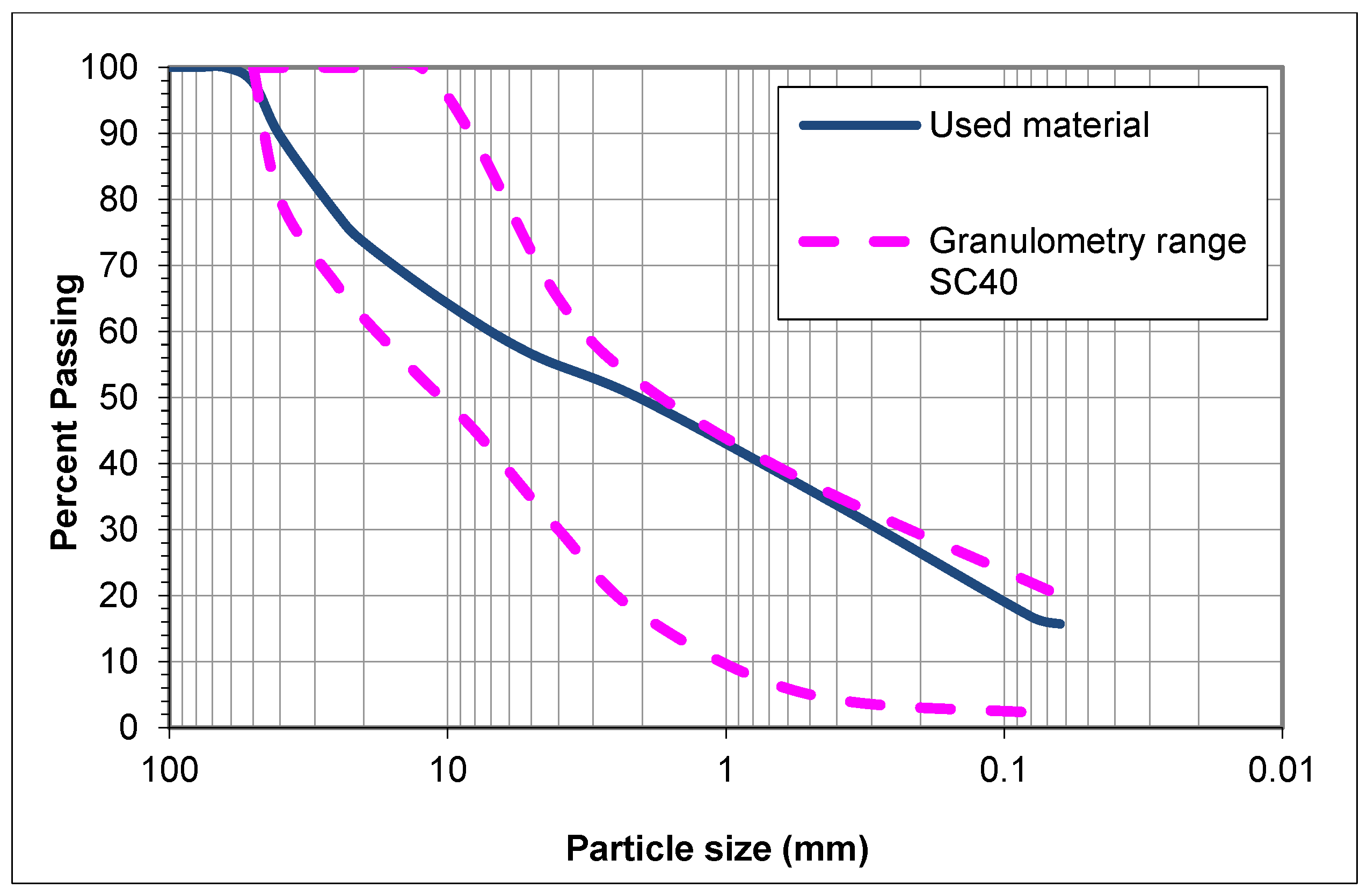
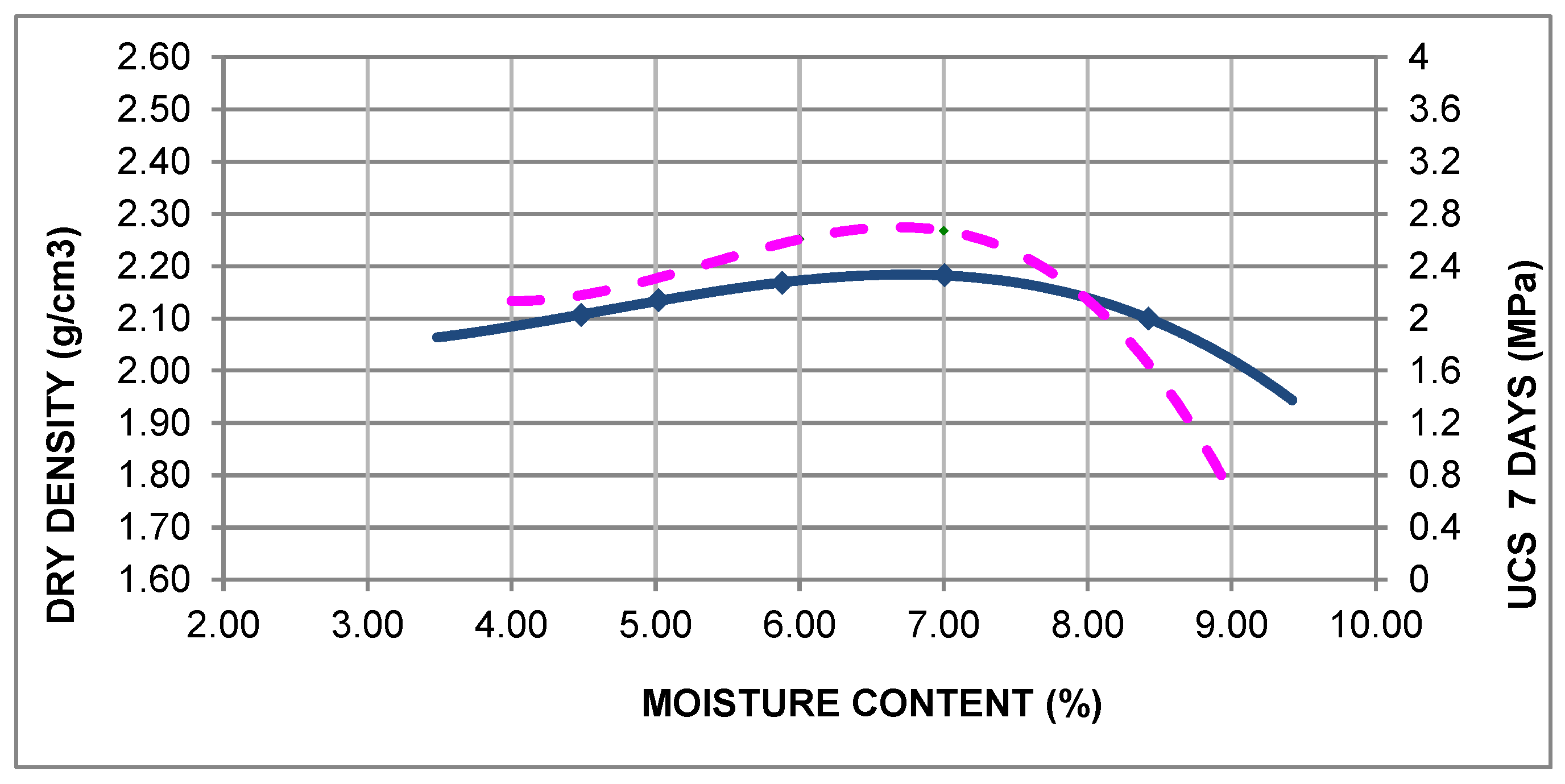
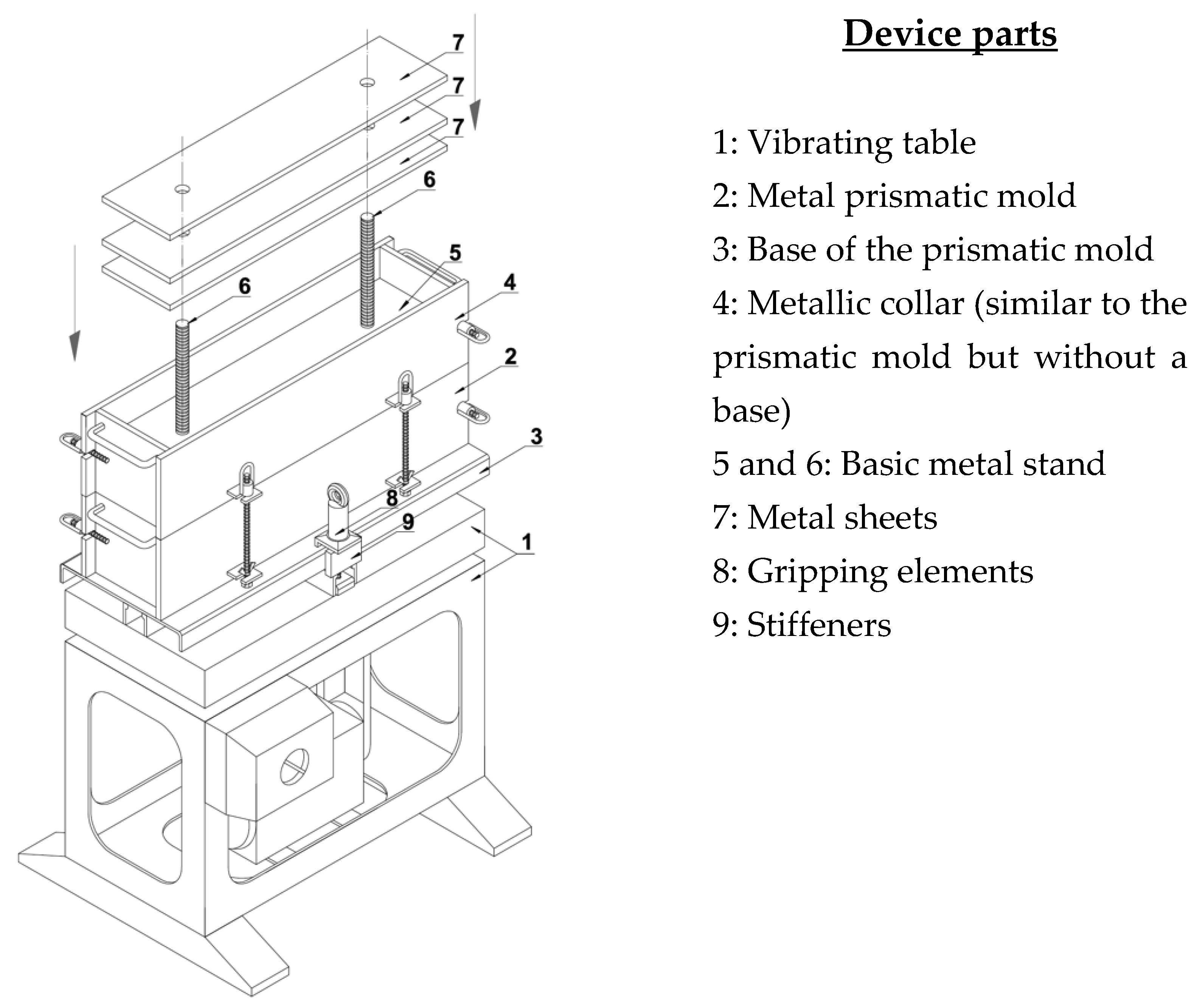
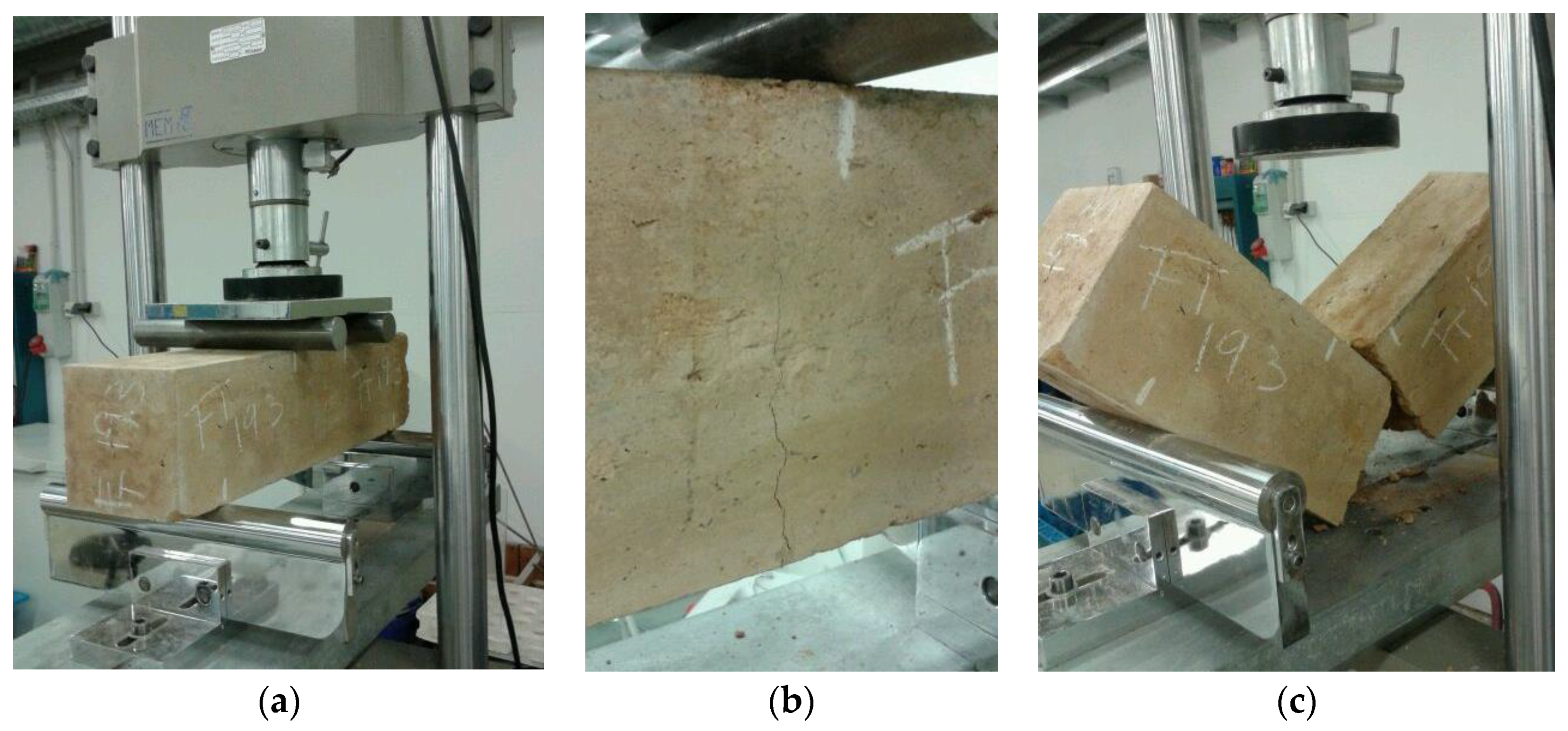

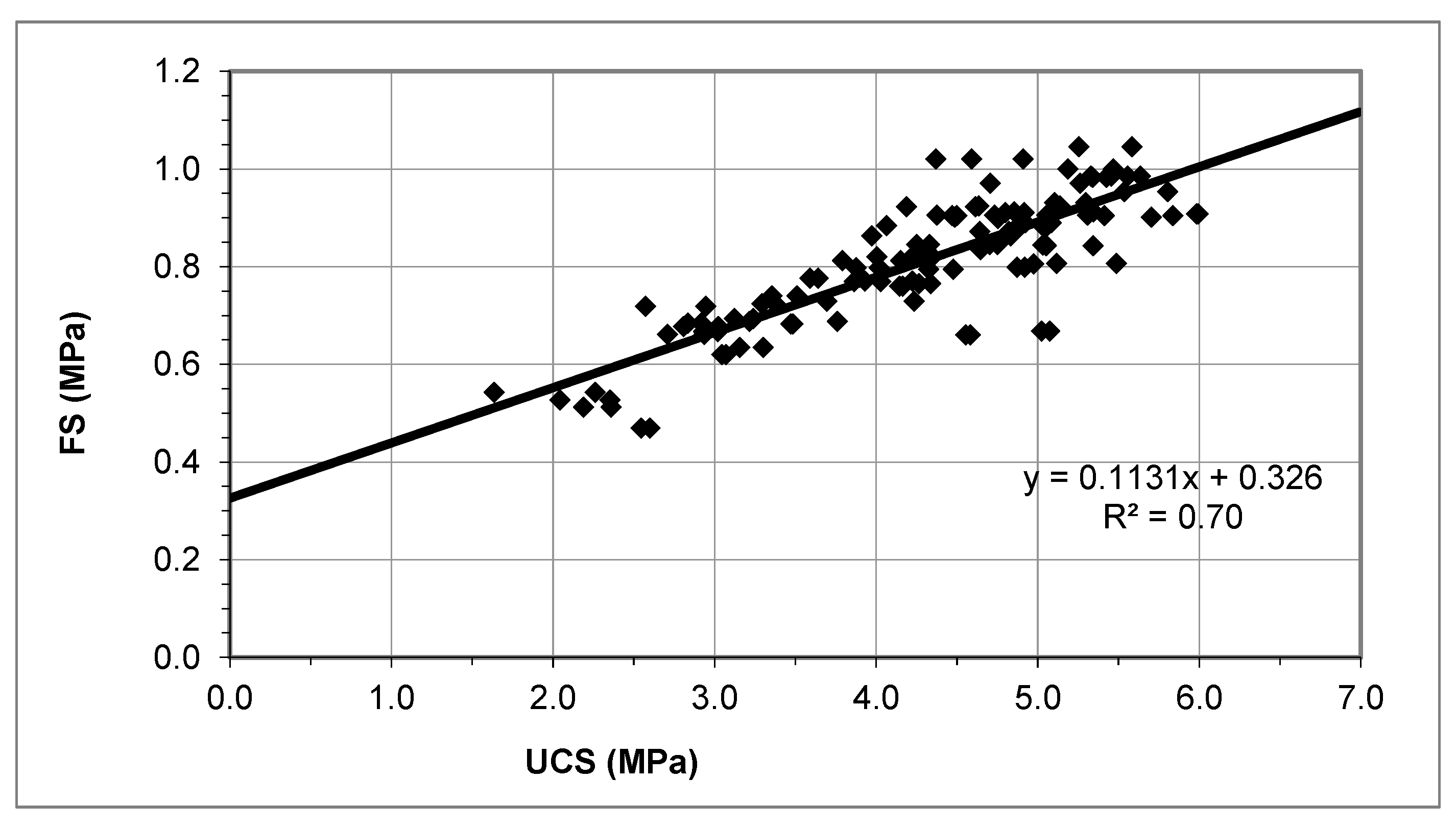
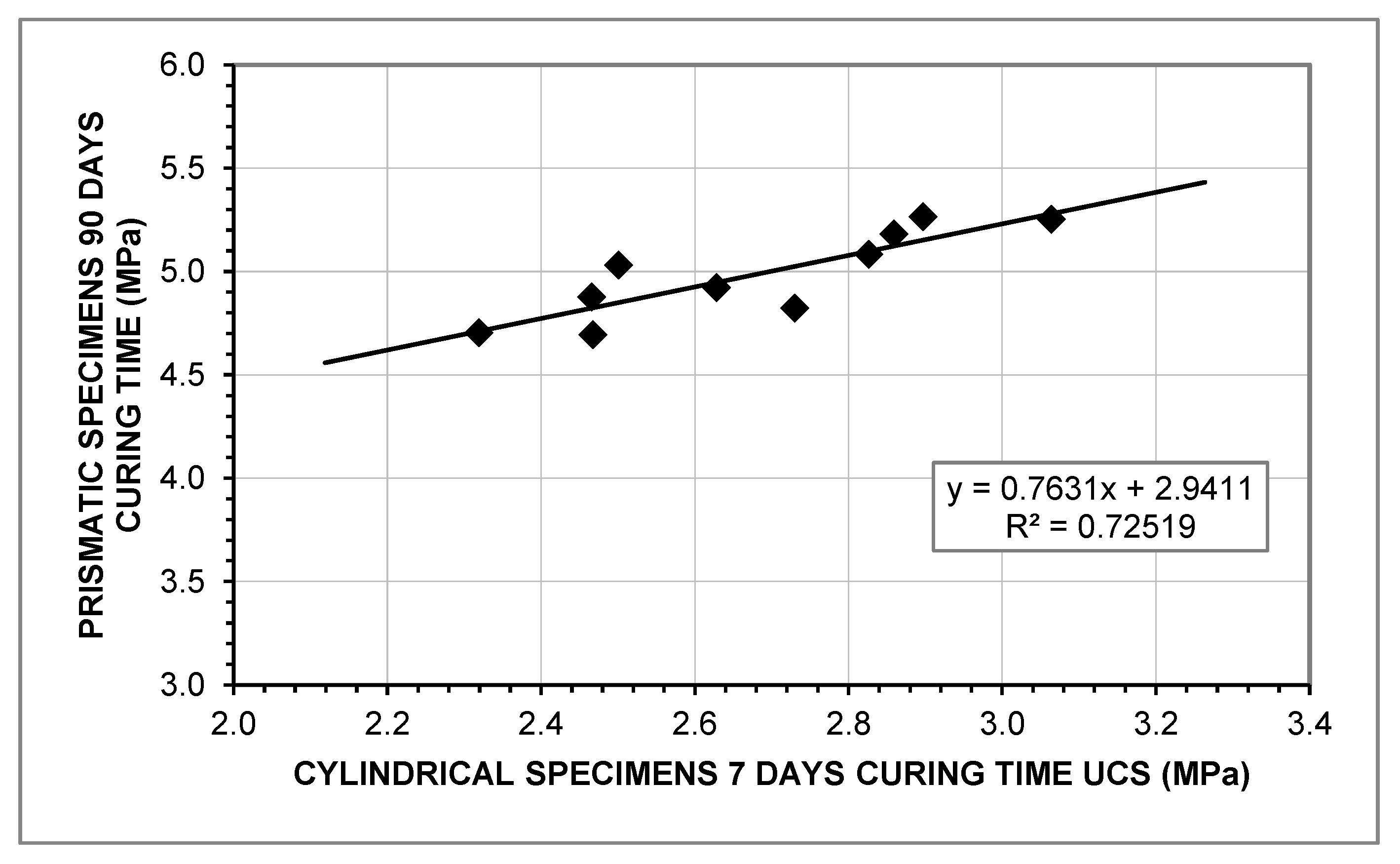
| Main Standardized Component | Value | Cement Standardized Specifications | Value |
|---|---|---|---|
| Clinker (K) | 45–64% | Sulfate | ≤3.5% |
| Silica fumes (D) 1 | - | Initial setting time | ≥75 min |
| Natural pozzolana (P) 1 | - | Final setting time | ≤720 min |
| Calcined natural pozzolans (Q) 1 | - | Expansion | ≤10 mm |
| Siliceous fly ash (V) 1 | 36–55% | UCS at 7 days | ≥16 MPa |
| Calcareous fly ash (W) 1 | - | UCS at 28 days | 32.5 ≤ R ≤ 52.5 MPa |
| Minority components | 0–5% | Puzzolanicity | 8 to 15 days |
| Chlorides | ≤0.10% | - | - |
| Country | UCS at 7 Days (MPa) |
|---|---|
| Spain [32] | 2.5/2.1 1 |
| United Kingdom [30] | CBM1: 2.5–4.5 |
| Australia [35] | ≤3 |
| New Zealand [31] | ≤3 |
| South Africa [34] | C2: 2–4 |
| China [33] | 3–5 |
| Analyzed item | Model 1a Without Intercept | Model 1b With Intercept |
|---|---|---|
| Slope | 0.1854 (p-value < 0.0001) | 0.1131 (p-value < 0.0001) |
| Intercept | - | 0.3261 (p-value < 0.0001) |
| R2 | 0.3965 | 0.6953 |
| Estimated standard error | 0.1031 | 0.0735 |
| Mean error | 0.0809 | 0.0538 |
| p-value (Kolmogorov–Smirnov) | 0.4857 | 0.0822 |
| Durbin–Watson | 0.9916 | 1.3736 (p-value = 0.0002) |
| Analysed item | Model 3a Without Intercept | Model 3b With Intercept |
|---|---|---|
| Intercept | - | 0.3230 (p-value < 0.0001) |
| UCS | 0.1836 (p-value < 0.0001) | 0.1124 (p-value < 0.0001) |
| Dummy | 0.0417 (p-value = 0.0748) | 0.0319 (p-value = 0.0564) |
| R2 fitted | 0.6990 | 0.6995 |
| Standard Error | 0.1022 | 0.0728 |
| F p-value (ANOVA) | <0.0001 | <0.0001 |
| Analysed item | Model 6b With Intercept | Model 8b With Intercept |
|---|---|---|
| Intercept | −1.0521 (p-value < 0.0001) | −1.0533 (p-value < 0.0001) |
| UCS | 0.5808 (p-value < 0.0001) | 0.5770 (p-value < 0.0001) |
| Dummy | - | 0.0348 (p-value = 0.0974) |
| R2 fitted | 0.7263 | 0.7302 |
| Standard Error | 0.0923 | 0.0916 |
| F p-value (ANOVA) | <0.0001 | <0.0001 |
| Author | Equation | Introduced Value | Estimated Value |
|---|---|---|---|
| Kersten [44] | FS = 0.2 × UCS (4) | UCS = 4.64 MPa | FS = 0.93 MPa |
| IECA-CEDEX [20] | FS = 0.2 × UCS (4) | UCS = 4.64 MPa | FS = 0.93 MPa |
| FS = 0.25 × UCS (5) | FS = 1.16 MPa | ||
| Lim and Zollinger [42] | FS = 0.2 × UCS (4) | UCS = 4.64 MPa | FS = 0.93 MPa |
| FS = 0.25 × UCS (5) | FS = 1.16 MPa | ||
| Ismail, et al [17] | USC = 1.475 × e0.763·FS (6) | FS = 0.86 MPa, t = 90 days | USC = 2.84 MPa |
| USC = 2.493 × FS0.826 × t0.109 (7) | USC = 3.59 MPa | ||
| Lim and Zollinger [42] | UCSt = UCS28 × t/(2.5 + 0.9 × t) (8) | UCS28 = 3.89 MPa | UCS90 = 4.20 MPa |
| Linares [66] | UCS28 = 0.6947 × UCS7 + 2.0354 (9) | UCS7 = 2.67 MPa | UCS28 = 3.89 MPa |
© 2019 by the authors. Licensee MDPI, Basel, Switzerland. This article is an open access article distributed under the terms and conditions of the Creative Commons Attribution (CC BY) license (http://creativecommons.org/licenses/by/4.0/).
Share and Cite
Linares-Unamunzaga, A.; Pérez-Acebo, H.; Rojo, M.; Gonzalo-Orden, H. Flexural Strength Prediction Models for Soil–Cement from Unconfined Compressive Strength at Seven Days. Materials 2019, 12, 387. https://doi.org/10.3390/ma12030387
Linares-Unamunzaga A, Pérez-Acebo H, Rojo M, Gonzalo-Orden H. Flexural Strength Prediction Models for Soil–Cement from Unconfined Compressive Strength at Seven Days. Materials. 2019; 12(3):387. https://doi.org/10.3390/ma12030387
Chicago/Turabian StyleLinares-Unamunzaga, Alaitz, Heriberto Pérez-Acebo, Marta Rojo, and Hernán Gonzalo-Orden. 2019. "Flexural Strength Prediction Models for Soil–Cement from Unconfined Compressive Strength at Seven Days" Materials 12, no. 3: 387. https://doi.org/10.3390/ma12030387
APA StyleLinares-Unamunzaga, A., Pérez-Acebo, H., Rojo, M., & Gonzalo-Orden, H. (2019). Flexural Strength Prediction Models for Soil–Cement from Unconfined Compressive Strength at Seven Days. Materials, 12(3), 387. https://doi.org/10.3390/ma12030387








